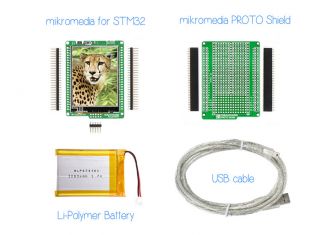
We strongly encourage users to use Package manager for sharing their code on Libstock website, because it boosts your efficiency and leaves the end user with no room for error. [more info]

Rating:
Author: MIKROE
Last Updated: 2016-02-23
Package Version: 1.0.0.0
Category: Measurement
Downloaded: 1073 times
Followed by: 3 users
License: MIT license
We're proudly presenting the second Let's Make project from our Intern's lab. This Pedometer consists of a mikromedia for STM32-M4, a mikromedia Proto shield and LiPo battery. Let's measure how far you walked with this Let's make. A pedometer is a portable device that counts each step a person takes.
Do you want to subscribe in order to receive notifications regarding "Let's Make - Pedometer" changes.
Do you want to unsubscribe in order to stop receiving notifications regarding "Let's Make - Pedometer" changes.
Do you want to report abuse regarding "Let's Make - Pedometer".
| DOWNLOAD LINK | RELATED COMPILER | CONTAINS |
|---|---|---|
| 1409846168_let_s_make___ped_mikroc_arm.zip [252.76KB] | mikroC PRO for ARM |
|

Kit features: mikromedia for STM32 M4, Proto Shield, Li-Polymer Battery, and USB cable.
View full imageWe're proudly presenting the second Let's Make project from our Intern's lab. This Pedometer consists of a mikromedia for STM32-M4, a Proto shield and LiPo battery.
For sensor Pedometer uses ADXL345 3-axis digital accelerometer: http://www.analog.com/static/imported-files/data_sheets/ADXL345.pdf
The touchscreen displays number of steps and duration of walking. Message “no movement” is written when there is no movement. Also, the interface has START and STOP button. Algorithm samples the accelerometer data every 0.5 seconds as you walk, and dynamically adapts the threshold.
This fine and demanding project was developed by Marko Lainovic, one of our talented and prosperous interns.

MathLab example of signal data filtering. Signals are received from ADXL345 3-axis digital accelerometer.
View full image
Marko Lainovic graduate at University of Belgrade Faculty of Electrical Engineering.
View full image